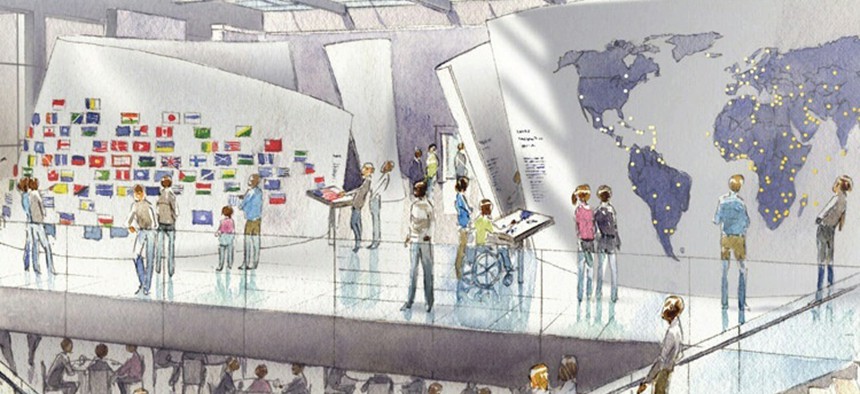
State Department illustration
New Diplomacy Museum Will Showcase More Than 'A Bunch of Pens'
GSA and State select a contractor to create pavilion near the National Mall for more than 6,000 artifacts.
The General Services Administration on Thursday announced selection of a construction contractor for the coming U.S. Diplomacy Center, a privately funded museum to be built at the 21st Street Northwest State Department headquarters in Washington.
Gilbane Building Co., which won what GSA called an “open and competitive process,” will receive $25 million to take 18 months to construct three exhibit halls (using existing and new space). The resulting 30,000-square-foot glass pavilion will feature “interactive exhibits, diplomatic simulations, and real-life stories of seasoned diplomats,” GSA said in a statement. “Diplomat docents” will act as tour guides, “explaining exhibit content and sharing personal stories about diplomacy.”
The architectural firm of Beyer Blinder Belle provided the modern concept design. On the drawing board since 2000, the project is funded by private institutional and individual donors through the Diplomacy Center Foundation, and has enjoyed support from all recent secretaries of State.
“I am often asked by friends and families what such a museum center might exhibit that would be of interest,” wrote center director David Ballard, a 28-year veteran diplomat, on the State Department website. “ 'A bunch of pens' is a frequent guess. If you look through our website’s sample representations of the over 6,000 artifacts we already professionally curate you will, in fact, find some pens -- and a lot more than pens. You will discover very personal tokens that represent the evolution of our diplomats’ efforts to live and work around the world in a way that honors American values and principles. You will develop a greater appreciation of the challenges they and their families endure and overcome because of their commitment to the United States of America, its institutions and its citizens.”
Organizers emphasize that the Diplomatic Center fulfills an educational function pondered since Benjamin Franklin’s time but never realized. Its proximity to the National Mall will make it a tourist attraction, they added. The exhibits will be free to the public, but visitors will be required to go through security detectors.







